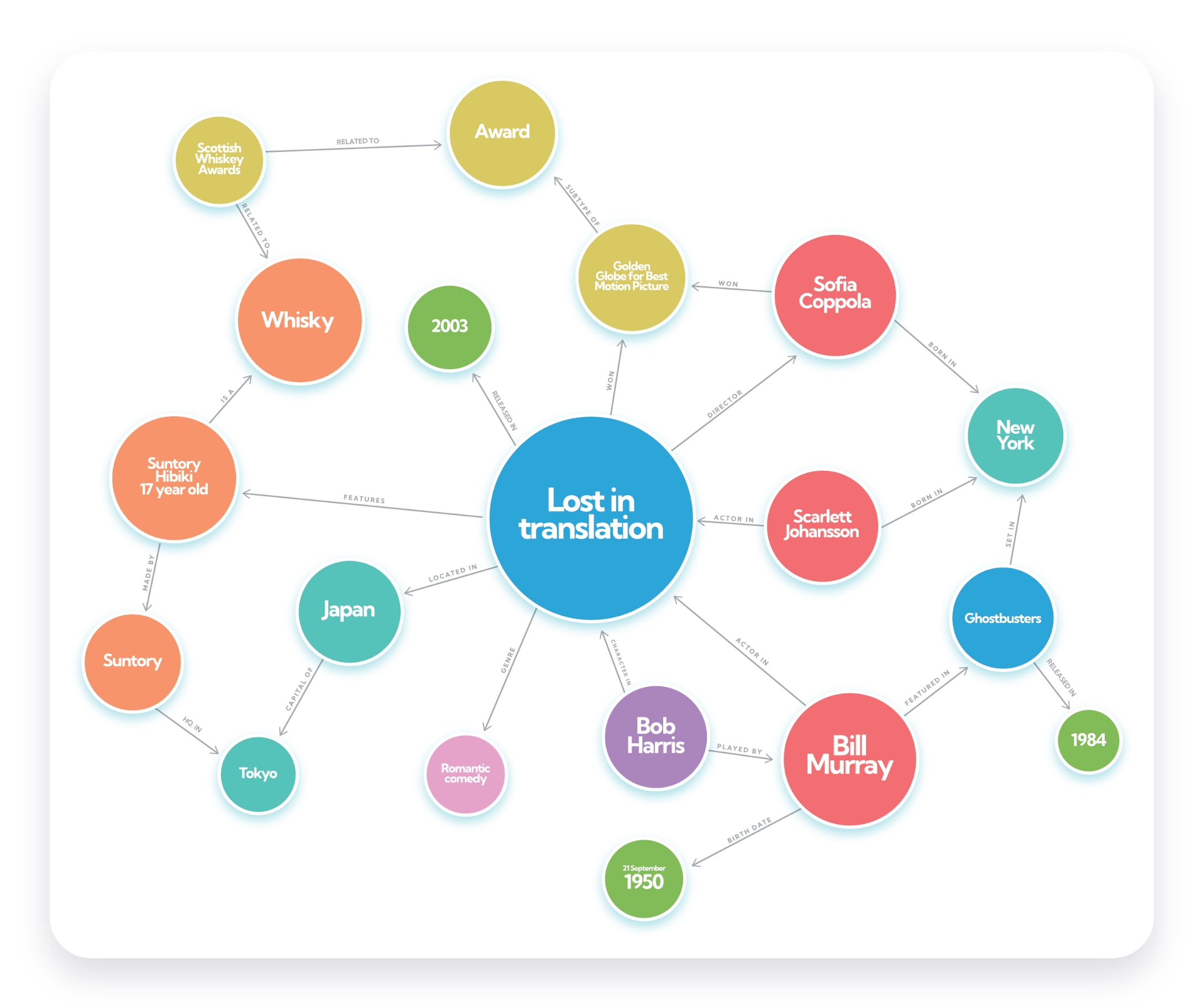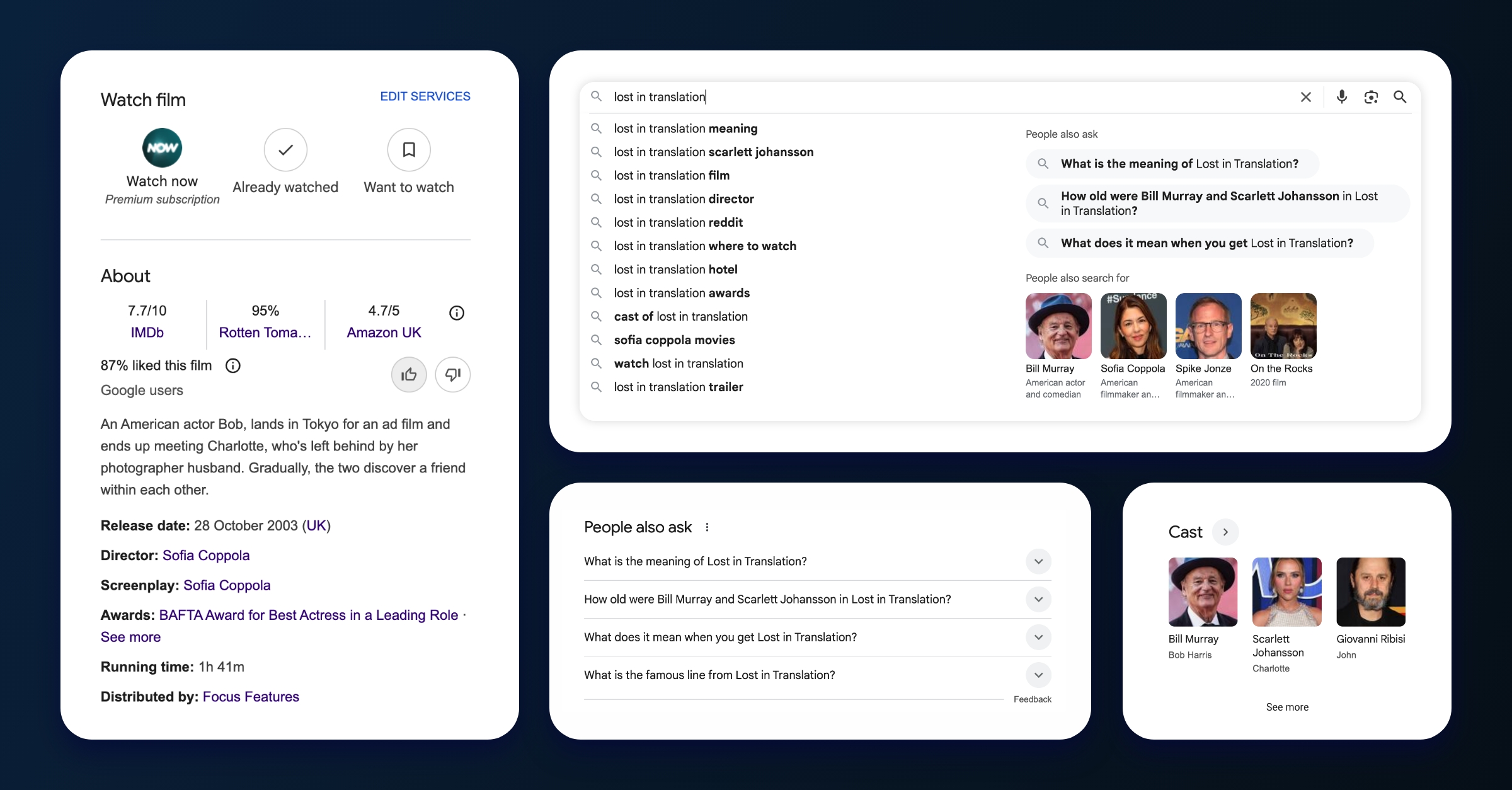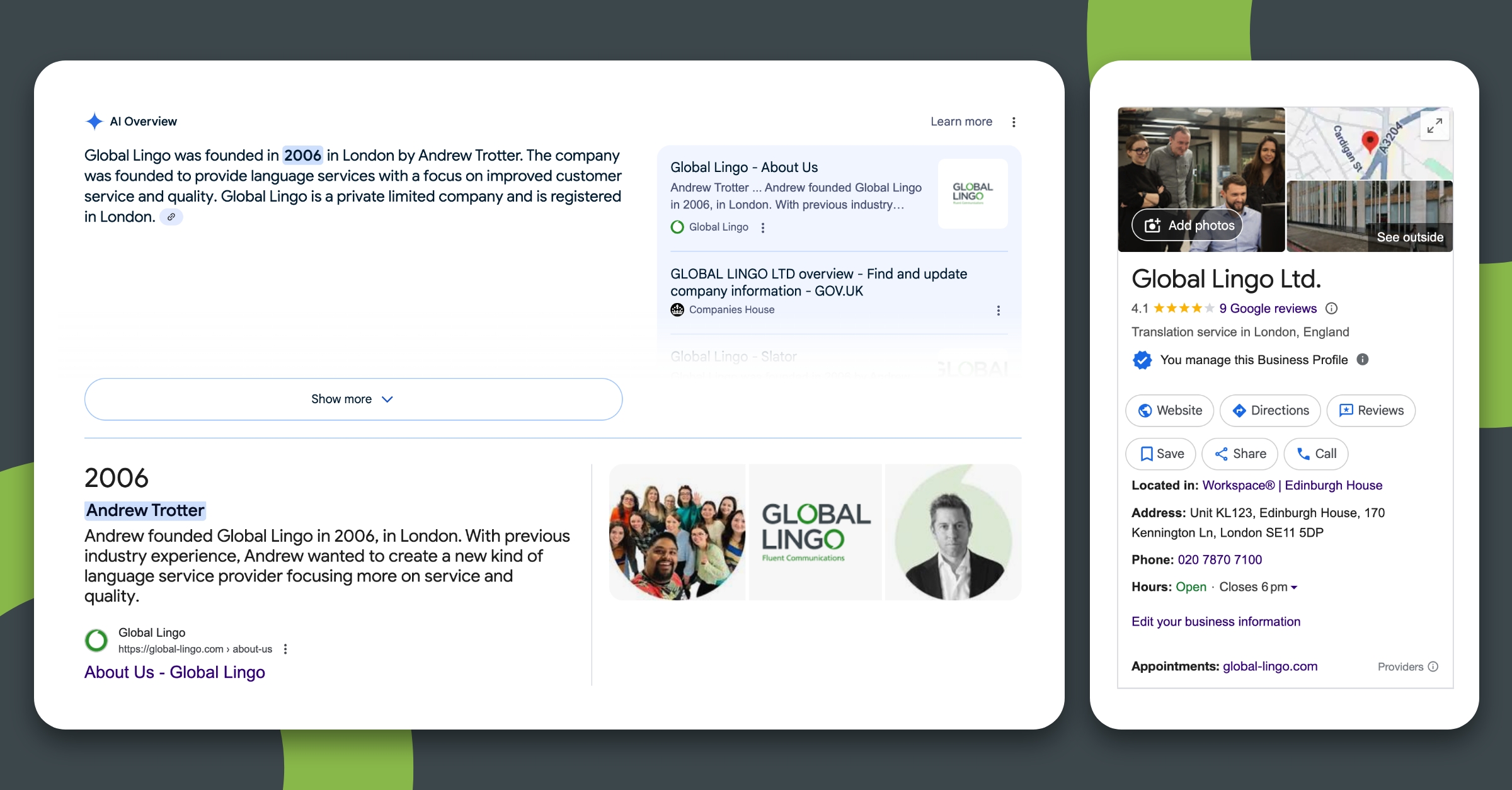The Google Knowledge Graph is a database of facts about people, places, and organizations. It helps Google connect queries to real-world entities instead of just matching keywords. For marketers, this changes how visibility works in search. It means your brand isn’t just found through content, but through the clarity of how your business is defined online.
This article explains what the Knowledge Graph is, how it influences search results, and what global marketing teams can do to help Google understand their brand across regions and languages.
What is the Google Knowledge Graph?
The Knowledge Graph is a semantic network that Google uses to understand the relationships between entities. An entity is anything that can be distinctly identified: a company, a service, a product, a person, an idea, a feeling, or a place. You’ll notice that they can be either tangible or intangible.

Google launched the Knowledge Graph in 2012, moving to ‘things, not strings’. Instead of returning pages with matching words, it tries to answer the user’s intent by referencing verified facts. You’ve seen it in action in the form of:
- Knowledge panels (e.g., when you search for a ‘thing’ and see structured data on the right side of the results)
- Autocomplete suggestions
- ‘People Also Ask’ boxes

More recently, the Knowledge Graph is powering features in AI-powered search results (such as Google’s Search Generative Experience), where entity clarity plays an even greater role in shaping what users see.
Why knowledge graphs matter for brand visibility
The Knowledge Graph determines what Google believes to be true about your company. If your business exists as a verified entity in the graph, it has a better chance of appearing prominently in search features like:
- Knowledge panels
- Image carousels
- Featured snippets
- Voice search results
- AI summaries
This improves visibility for both branded and non-branded search queries. It also helps reduce ambiguity, especially for companies with generic or similar names. Most importantly, entity recognition boosts trust. If Google sees your brand consistently described, structured, and cited across the web, it treats your information as reliable.
The simplest way to check if you’re company is a verified entity is to Google your company name and location. Then, assess the information that is displayed in the knowledge panel on the right-hand side. For a more advanced understanding, you can use the Knowledge Graph Search API. The example below is from the following search terms:
- “Global Lingo London” [To review local company data.]
- “When was Global Lingo Founded” [To review the associated founding date.]
- “Who founded Global Lingo [To review the associated founder.]

How Google builds its understanding of your brand
Google doesn’t rely on a single source to define your brand. It triangulates data from your site, structured data (like Schema.org), public databases, media coverage, and major profiles.
Here are the key sources that shape your entity profile:
- Your website: The most direct signal. Use clear descriptions of your business, services, team, and location.
- Structured data: Mark up key content using Schema.org vocabulary. Start with Organization, Service, LocalBusiness, and Person, where relevant.
- Wikidata: This is one of the most important sources. If your business has a Wikidata entry, Google can cross-reference it as a trusted source. Here’s an example for Lost in Translation.
- Social media platforms: Consistency across your social media accounts supports credibility and further. Ensure to update all platforms frequently with logos, hyperlinks, and associated stakeholders.
- Business directories: Again, consistency across trusted directory websites establishes your business and supports your credibility.
- Third-party references: Articles, press releases, conference appearances, case studies, or listings from trusted sources.
Google uses a process of corroboration. If all these signals point to the same descriptions and relationships, your entity becomes more stable in the Knowledge Graph.
The impact on international SEO
For global businesses, the Knowledge Graph can lead to potential search infrastructure issues if left unchecked. When your company operates in multiple languages or markets, Google needs to connect all regional versions to the same entity. If your German, French, and English websites describe your business differently, you risk fragmenting your presence.
Here’s what matters:
- Use hreflang tags correctly to signal language and regional versions.
- Translate structured data for each page where possible.
- Maintain consistent descriptions of your brand, services, and team across languages.
- Canonical URLs should point to local versions but be linked from a central organizational entry.
Depending on the size of your company and available resources, we recommend utilizing localization experts in your industry or niche. This approach ensures nothing is left unchecked. We offer comprehensive international SEO services, combined with tailored website localization solutions in over 150 languages.
How to get into Google’s knowledge graph
You don’t need to be a public or listed company to benefit from entity recognition. Here are some small steps to help you improve your business’s entity presence:
- Increase your PR and link building. The more trusted references you have, the better established your business will be.
- Create a Google My Business listing.
- Add structured data to your homepage and about pages using Organization schema.
- Standardize service descriptions across all digital assets. Use the same names, definitions, and formats.
- Create or claim a Wikidata entry if it doesn’t already exist.
- Create or claim a Wikipedia page if it doesn’t already exist.
- Ensure your company information is consistent across social media platforms.
- Register your company on trusted directory sites and keep them up to date. Look for directories in your industry niche to establish associations in your specialist area. Here are some general listing sites to help you get started:
- Yell
- Yelp
- Crunchbase
- ZoomInfo
- Download our knowledge graph checklist below to see more trusted directories.
- Use Schema markup for services, people, FAQs, and reviews.
- Interlink translated pages clearly and ensure metadata is localized, not just translated.
These steps reduce ambiguity, especially when your company name is not unique or when you serve multiple sectors.
For a more comprehensive audit and plan, download our knowledge graph checklist below:

Common mistakes & pitfalls
- Using inconsistent brand names or abbreviations across languages
- Not using Schema.org markup on key pages
- Leaving social or business profiles outdated
- Publishing content with conflicting service definitions across regions
- Ignoring Wikidata and other open databases
These issues prevent Google from confidently matching your content to a single, trusted entity.
Summary
The Knowledge Graph affects how Google sees your business. It’s not something you can directly control, but you can influence it through consistency, clarity, and structure.
For global brands, the stakes are higher. Multilingual content, regional teams, and decentralized marketing make it easier to lose cohesion. But with the right signals in place, your brand becomes more visible, more authoritative, and better understood across every market you serve.
For a quick fix, download our knowledge graph checklist. For international businesses seeking to follow best practices and stay ahead of the curve, don’t hesitate to get in touch with us today.